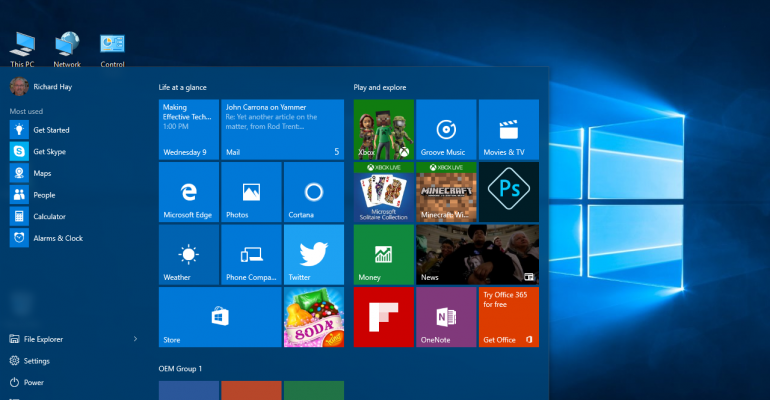Microsoft has designated Windows 10 Version 1607, aka the Windows 10 Anniversary Update, as the new Current Branch for Business (CBB) release but what exactly does that mean?
To answer that question let me provide some background.
When Microsoft released Windows 10 in July of 2015 it introduced an entirely new update process called Windows as a Service (WaaS) and a series of servicing branches of the operating system to help businesses, enterprises, and other organizations manage how often major updates were pushed out to devices in those entities.
These servicing branches come in three versions according to Microsoft:
Current Branch (CB)
In the CB servicing model, feature updates are available as soon as Microsoft releases them. Windows 10 version 1511 had few servicing tool options to delay CB feature updates, limiting the use of the CB servicing branch. Windows 10 version 1607, however, includes more servicing tools that can delay CB feature updates for up to 180 days. The CB servicing model is ideal for pilot deployments and testing of Windows 10 feature updates and for users such as developers who need to work with the latest features immediately.
When Microsoft officially releases a feature update for Windows 10, that update is marked for CB, making it available to any PC not configured to defer feature updates so that those machines can immediately install it. Organizations that use Windows Server Update Services (WSUS), Microsoft System Center Configuration Manager, or Windows Update for Business, however, can defer CB feature updates to selective machines by withholding their approval and deployment. In this scenario, the content available for CB will be available but not necessarily immediately mandatory, depending on the policy of the management system. Only one CB build of Windows is supported at a time, so those clients not on the most current build will not receive quality updates (after a 60 day grace period) until the most current feature update has been installed.
Current Branch for Business (CBB)
Organizations typically prefer to have a testing cycle before broadly deploying new features to business users. For Windows 10, most pilot testing will be done using the CB servicing branch. In contrast, the CBB servicing branch is typically used for broad deployment. Windows 10 clients in the CBB servicing branch receive the same build of Windows 10 as those in the CB servicing branch, just at a later time. CB releases are transitioned to CBB after about 4 months, indicating that Microsoft, independent software vendors (ISVs), partners, and customers believe that the release is ready for broad deployment. Therefore, CB and CBB have an inherent “staging” effect. Both of these branches have a purpose in the overall deployment process for an enterprise, providing another layer of testing capabilities in addition to the traditional phased deployment methods to specific groups of machines. Microsoft will support two CBB builds at a time, plus a 60 day grace period. Each feature update release will be supported and updated for a minimum of 18 months.
Long Term Servicing Branch (LTSB)
Specialized systems—such as PCs that control medical equipment, point-of-sale systems, and ATMs—often require a longer servicing option because of their purpose. These devices typically perform a single important task and don’t need feature updates as frequently as other machines in the organization. It’s more important that these devices be kept as stable and secure as possible than up to date with user interface changes. The LTSB servicing model prevents Windows 10 Enterprise LTSB devices from receiving the usual feature updates and provides only quality updates to ensure that device security stays up to date. With this in mind, quality updates are still immediately available to Windows 10 Enterprise LTSB clients, but customers can choose to defer them by using one of the servicing tools mentioned in the section Servicing tools.
Microsoft never publishes feature updates through Windows Update on devices that run Windows 10 Enterprise LTSB. Instead, it typically offers new LTSB releases every 2–3 years, and organizations can choose to install them as in-place upgrades or even skip releases over a 10-year life cycle.
As you can see in the description of CBB, this is the most stable build of any major Windows 10 Feature Update that gets released and stability is a key decision factor for organizations looking to move their users to the new features in that CBB build.
Keep in mind that the designation of Windows 10 Version 1607 as a CBB release also triggers a couple of key dates when it comes to CBB build Windows 10 Version 1507 which was the initial release of Windows 10 from July 2015.
Since Microsoft only supports two CBB releases at any time, Windows 10 Version 1507 will enter its 60 day grace period for updates in January 2017. The final patches for this version of Windows 10 should be released in March 2017 during the normal Patch Tuesday process.
By shutting down updates in March 2017 for Windows 10 Version 1507 that means this build will have received 20 months worth of support - which exceeds the minimum of 18 months designated in Microsoft's Windows 10 Servicing documents.
Any organizations that have opted to defer upgrades on their Windows 10 systems will see this new CBB release start to roll out to their users in January through Windows Update. If you use WSUS or System Center Configuration Manager to push updates the deployment date is at the discretion of the system admin but keep in mind they should be pushed out ahead of the end of Version 1507's grace period of 60 days mentioned above.
Have more servicing questions about Windows 10? Then be sure to read everything from Microsoft about the Windows 10 servicing process in their Windows IT Center Update Windows 10 in the Enterprise documents.
But, wait...there's probably more so be sure to follow me on Twitter and Google+.





